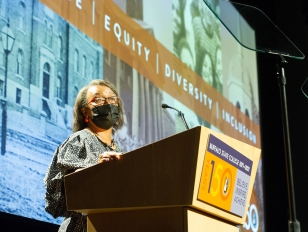
Buffalo State College President Katherine Conway-Turner officially launched Buffalo State College’s 150th anniversary celebration on Friday, September 17, with an address to the campus community in the Performing Arts Center at Rockwell Hall.
Her speech was part of Buffalo State College Day, a special event to kick off the yearlong celebration of the landmark anniversary. She described the amazing stories that constitute Buffalo State—from its inception in 1871 to today—and how far it’s come.
In closing, Conway-Turner said, “I look toward building on the strong foundation that has been laid during the past 150 years. Tomorrow requires new tools, new experiences, and an innovative approach to the education of our Buffalo State students.
“We will accomplish this by working collaboratively with the SUNY system, the state of New York, our College Council and Foundation Board, our alumni base, the many donors and friends of the college, and our partners near and far. Together, we will bring JEDI excellence to the forefront and meet the needs of today and tomorrow.”
The Performing Arts Center celebration included music by the African American Cultural Center’s Kakilambe Dance and Drum Performance Company, performances by Buffalo State student dancers, and a short video history of the college.
Buffalo State alumni Claudine Ewing, ’92, anchor at WGRZ-TV, and Matt Bové, ’13, sports director at WKBW-TV, served as masters of ceremonies for the event, which was followed by a reception on the front lawn of Rockwell Hall.
On Friday evening, Buffalo City Hall, the Electric Tower, Curtiss Hotel, Central Library, and other area landmarks, as well as Buffalo State’s Rockwell Hall, Whitworth Ferguson Planetarium, and Burchfield Penney Art Center, were illuminated in orange in honor of the sesquicentennial celebration.
Photos by Bruce Fox, campus photographer.
Video by Ken Giangreco, John Myers, and David Ross, Buffalo State College Creative Services.
Outdoor lighting program coordinated by the Buffalo Landmark Illumination Team (BuffaloLIT).
“We were once a small and scrappy college that singularly focused on the very important goal of developing teachers to go out into the world and shepherd our youth to new heights,” Conway-Turner said. “But our dream grew, and now we stand as a campus with a significant range of programs. We touch the city of Buffalo, Western New York, New York state, the entire country, and even the world.”
She also recognized the important roles Buffalo State plays in the community as an economic engine, an urban-engaged campus, and a significant anchor institution.
“We are a campus that forges community connections through the research we focus on and the many ways we contribute to the social, economic, and cultural landscape of Western New York,” she said. “We breathe life into our urban-engaged mission. We are also a part of the national and international dialogue on issues related to transformative, creative, civic-engaged, and innovative education across the disciplines.”
Throughout the coming year, she said, the college will reflect on both the good and the troubled times throughout its history, as well as the many ways the campus community has persevered.
“Our dreams have not always allowed us to move ahead in measured ways, but we have always moved ahead, and we have grown in significant and important ways,” Conway-Turner said. “Step by step, we have all arrived here together to celebrate our significant history and look toward our next chapters.”
Looking toward the future, Conway-Turner said she’s confident Buffalo State will build on its tremendous foundation to “become more than most diverse campus within the SUNY system; we will be the campus that forges the critical path to illuminate true inclusion that benefits all individuals, New York state, and our entire world.”
She also highlighted Buffalo State’s ongoing commitment to justice, equity, diversity, and inclusion, or JEDI, and the specific ways in which the JEDI focus will expand over the next two decades:
Some content on this page is saved in PDF format. To view these files, download Adobe Acrobat Reader free. If you are having trouble reading a document, request an accessible copy of the PDF or Word Document.
